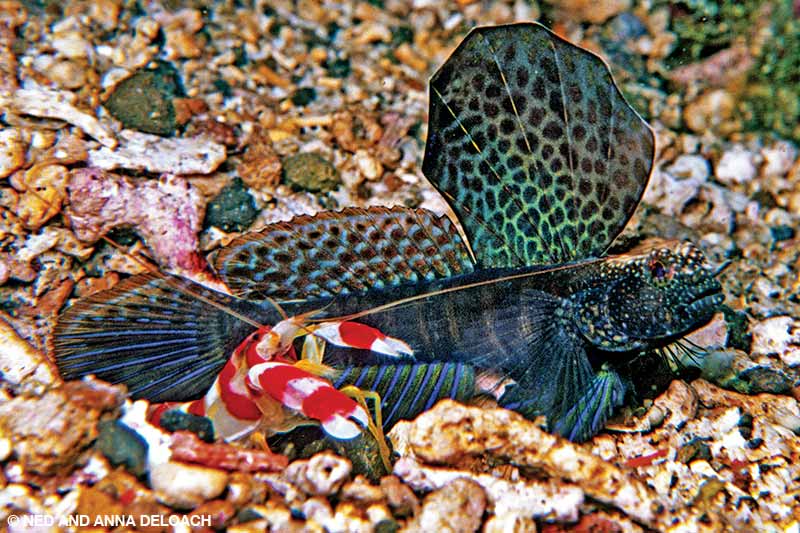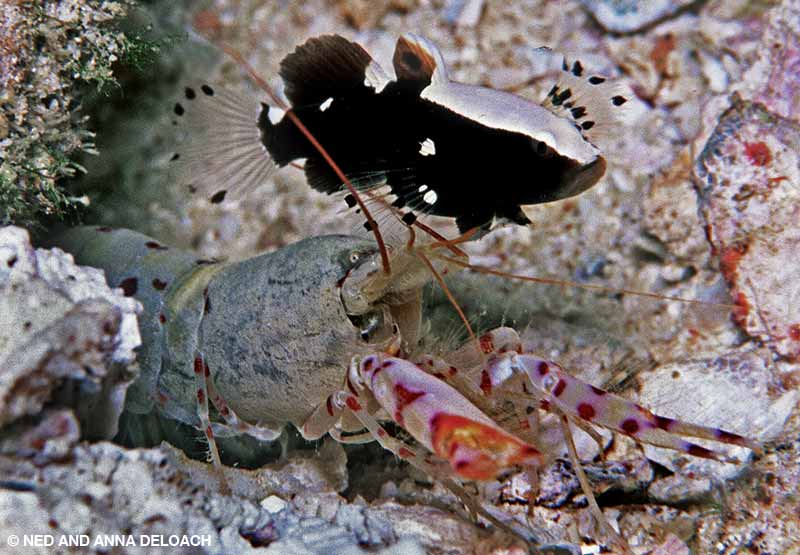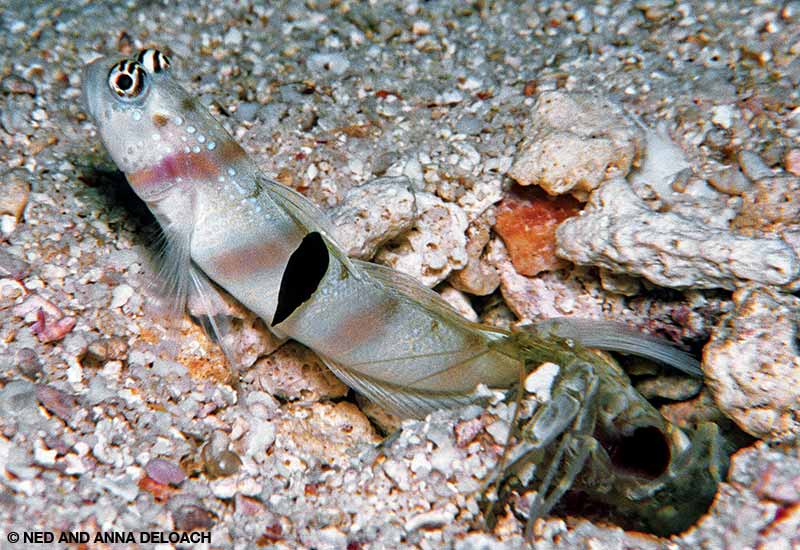Interactions between different species, whether above or below water, typically revolve around “red in tooth and claw” confrontations between predators and prey. At the opposite and more harmonious end of the spectrum, a scattering of unrelated species coevolved to form lifelong alliances for their mutual security.
These relatively rare go-along-to-get-along partnerships provide a net benefit for both parties, improving each species’ reproductive success — the pinnacle of natural selection. The strategy’s apparent success makes one wonder why mutualistic relationships don’t occur more often.
The close living arrangement between weak-eyed alpheid snapping shrimp and sharp-eyed partner gobies is a classic example of symbiosis in the sea. Goby-associated snapping shrimp are master sand dwellers outfitted with precision-jointed arthropod armor and a pair of hulking claw arms well suited for excavating soft sediment. While tunneling beneath the surface, the shrimp have little to fear from predators, but on the surface they make easy pickings for cruising carnivores.

Life in the open is even more perilous for gobies. The slender 2- to 3-inch fishes have few problems keeping tabs on lurking predators, but finding a safe place to hide is another matter. To improve their chances of survival, the homeless gobies and nearsighted shrimp team up to take on the world.
The gobies spend large portions of their day perched on furrows leading from burrow openings, where they uphold their primary part of the bargain by acting as sentinels, while their forever-busy partners shovel debris above ground. To sweeten the deal, the gobies supplement the shrimps’ conventional diet of substrata detritus by dutifully depositing their droppings inside the tunnels.
The instant a shrimp appears above ground, it positions at least one antenna on the goby, usually near the tail. Alerts of possible danger range from a slight tail twitch, indicating caution, to a thrashing alarm signal. When a code red is issued, it takes only tenths of a second for both animals to disappear inside their burrow. But even in a panic there are proprieties: The shrimp always enters first.
The inch-wide subterranean passages where the partners hide out typically cuts through 2 to 4 feet of sand and rubble a foot or so beneath the surface. The descending burrows occasionally branch and often include fist-sized chambers hollowed out beneath rocks and coral rubble for support. The industrious shrimp have their work cut out for themselves maintaining their convoluted creations. The instability of the tunnels’ upper sections requires continual attention, and collapsed openings are common.

A mated pair of shrimp and a single guardian goby typically share a burrow. During breeding season, the number increases when neighboring female gobies come courting and leave behind clutches of eggs for the males to keep safe.
The shrimpgobies are a challenge to sneak up on without sending them diving below ground. The feat can be accomplished, however, with a bit of patience and practice. But first, you have to find their burrows.
There is only a single shrimpgoby species in the Caribbean, but the group proliferates in the tropical Indo-Pacific, where more than 100 species inhabit the sandy plains and muddy inshore bottoms across. When crossing sandy patches, watch for gobies perched on the edge of furrows leading to burrow entrances. When you find one, rest assured there will be others around. Once you’ve determined a target, flatten your profile and inch forward while continually monitoring the gobies’ nervous nature to gauge every move.
The time spent is worth the effort. Watching the brawny crustaceans busily shoring up crumbling entranceways from an arm’s length away is a hoot. They go about their Herculean tasks like tightly wound robots, heaving and hoisting, jamming and cramming, poking and plowing, and at times lifting shell fragments twice their weight with their powerful claws in never-ending battles against the shifting sand.
Don’t forget the gobies. The closer you approach, the more magical they become. While the majority wears sensible camouflage wardrobes, others display bold colors and sport high, handsome fins as if taunting predators to attack. It seems these flashier shrimpgobies, including several of our favorites pictured here, are among the most difficult to approach. But, as things turned out, one of the least-elegant species proved to be the most compelling.

Its story began for us some years ago when Anna happened upon an obscure scientific paper from Japan describing the first documentation of a shell-less mollusk associating with a fish — in this case, small black nudibranchs clinging by their mouths to the shrimpgobies’ fins. Examination of hosts revealed gaping sections of fin rays and membrane missing from where the hitchhikers had once attached.
Anna naturally became obsessed with something so wondrously wacky and for years scrutinized every shrimpgoby we passed. Then one fine morning in Fiji, bingo! There it was: a jet-black, parasitic nudibranch chowing down on a goby’s dorsal fin — another example of symbiosis, but in this instance, one far less egalitarian.
En savoir plus
Watch the relationship between a goby and a pistol shrimp in this video.
© Alert Diver — Q2 2021